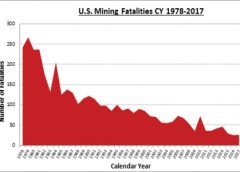By David G. Zatezalo
Mine safety in the United States has improved tremendously in the last few decades, thanks to the combined efforts of miners, mine operators, equipment manufacturers, and regulatory and enforcement agencies such as ours – the Department of Labor’s Mine Safety and Health Administration (MSHA).
The occupation of mining is no longer among our nation’s most dangerous. While mines continue to employ hundreds of thousands of workers, we now count annual mining fatalities in the low double digits rather than in the hundreds.
Still, at MSHA, we are determined to do better. It is our mission to save miners’ lives and we take that mandate very seriously. Every mining fatality matters to us as if it were a loss in the family. We thoroughly investigate each one, seeking information that can be used to prevent similar incidents in the future. Data from those investigations also help direct our outreach and enforcement efforts.
Recently we’ve identified the classification of powered haulage – including large surface equipment and belt conveyors – as responsible for an inordinate number of fatal accidents. Powered haulage accounted for half of the 28 fatalities recorded in 2017 and more than half of the 14 recorded so far this year. Each one of those accidents was preventable. In some cases, a life was lost because of a moment of distraction, or a shortcut taken doing a routine task.
How can we prevent these all-too-human lapses from tragically taking a life? MSHA is focused on finding effective, feasible answers to that question through technology and other means, and we are seeking ideas from all stakeholders – miners, mine operators and equipment manufacturers.
To encourage input from all knowledgeable parties, MSHA has issued a formal Request for Information. Comments will be accepted until Dec. 24, 2018, at www.regulations.gov.
Our questions include:
- Can proximity detection devices be used to prevent large mobile equipment such as haul trucks and front end loaders from running over occupied vehicles?
- How can we ensure seatbelt usage among equipment operators?
- Can technology help ensure that workers performing work around belt conveyors are protected from injury and death?
As background, our investigations have noted that blind areas have contributed to mobile equipment operators colliding with other equipment and striking miners. Engineering controls, such as collision warning systems and collision avoidance systems, could provide warnings when other vehicles, miners or structures pose a potential collision hazard, or activate machine controls, such as automatic braking, to avoid collisions.
Since 2007, there have been 20 fatal accidents in surface coal and metal and nonmetal mines involving bulldozer operators and haul truck drivers who traveled over the edge of the highwall or dump point. Systems that integrate technologies such as GPS, radar and radio frequency identification tagging could help equipment operators better identify the edges of highwalls or dump points. Ground and aerial markers also could help equipment operators identify their locations relative to the edges of highwalls or dump points when pushing or dumping material.
MSHA has determined that mobile equipment operators are more likely to survive rollover and tipping accidents when they are wearing a seatbelt. However, not all drivers take that precaution. MSHA examined 38 fatal accidents that occurred since 2007 involving mobile equipment in which the deceased was not wearing a seatbelt. MSHA determined that 35 of the victims (92 percent) might have survived had they been wearing a seatbelt. We believe that engineering controls could increase the use of seatbelts by equipment operators.
Belt conveyors are another type of powered haulage that has accounted for an outsized share of fatalities. Since 2007, there have been 18 fatalities related to working near or around belt conveyors. The great majority involved miners becoming entangled in belt drives, belt rollers and discharge points. Factors that contribute to entanglement hazards include inadequate or missing guards, inadequate or an insufficient number of crossovers in strategic locations, and/or inappropriate lock out/tag out procedures. Systems that can sense a miner’s presence in hazardous locations and/or ensure machines are properly locked out and tagged out during maintenance could reduce fatalities.
We can’t be complacent in our successes in reducing mining related injuries and deaths. Mining can be inherently dangerous work and everyone’s vigilance is required to keep it safe. We welcome your ideas as we move forward to improve safety in powered haulage classifications, and all mining activities.
David G. Zatezalo is Assistant Secretary Mine Safety and Health. Zatezalo is a native of West Virginia and has spent a lifetime working in mining. He began his career as a union miner and since then has held positions at a number of companies as shift foreman, engineering superintendent, mine manager, vice president of operations and chief executive officer. Assistant Secretary Zatezalo has worked in mining all across the United States and internationally in Australia. Zatezalo has a degree in mining engineering from West Virginia University and is a registered professional engineer in Ohio and West Virginia. He also has an MBA from Ohio University. He is the past chairman of the Kentucky Coal Association and the Ohio Coal Association. He’s also been a member of the Mine Rescue Veterans of the Pittsburgh District.

